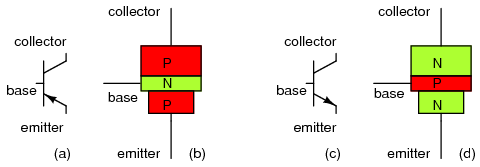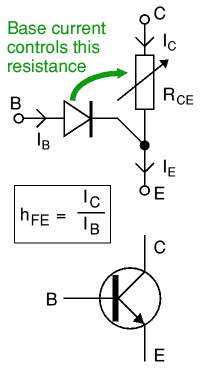//Transistors
Introduction to Transistors
A transistor is a semiconductor with 3 leads:
- Emitter
- Base
- Collector
There are two types of transistors: bipolar and field-effect transistors (FETs). Unlike bipolar transistors, the leads of FETs are referred to as gate, source and drain.
Bipolar transistors can be divided into two categories: NPN and PNP. NPN transistors act like normally opened switches. PNP transistors act like NC switches.
Function
Transistors can amplify the current or can be used as switches.Operating Values
These values vary and you must refer to the datasheets.Basics
Bipolar Transistors are composed of three layers:- An Input Layer, the emitter
- A Control Layer, the base
- An Output Layer, the collector
Layers are formed by doping silicon with traces of impurities. Silicon treated with Boron produces negative type material. It is negative because it has a surplus of electrons. Doping the silicon with Phosphorous produces positive material, or material with a surplus of electron holes.
Silicon transistors are considered semiconductors because they conduct only a small amount of current unless a change in voltage is applied at a juncture.
When current is applied to the input layer, or the emitter of an NPN transistor, electrons flow to the P-type base and fill the positive material, or electron holes. When the holes are filled, the material no longer conducts current. But when a small voltage is applied to the control layer, or base, that current will produce additional holes which in turn allows current to flow from the emitter through the base to the collector.

The difference between a PNP transistor and an NPN transistor is the polarity, or proper biasing of the junctions. Transistors restrict the amount of current passed according to a smaller, controlling current. The main current from collector to emitter (PNP) or from emitter to collector (NPN) depends on the type of transistor it is. The small current that controls the main current goes from base to emitter (PNP), or from emitter to base (NPN), depending on the kind of transistor it is.
The arrow always points against the direction of electron flow.

Bipolar transistors are called bipolar because the main flow of electrons through them takes place in two types of semiconductor material: P and N, as the main current goes from emitter to collector (or vice versa). Two types of charge carriers: electrons and holes, comprise the main current through the transistor.
All currents must be going in the proper directions for the device to work as a current regulator. The small, controlling current is usually referred to as the base current because it is the only current that goes through the base wire of the transistor.
The large, controlled current is referred to as the collector current because it is the only current that goes through the collector wire.
NPN transistor

- The base-emitter junction behaves like a diode.
- A base current IB flows only when the voltage VBE
across the base-emitter junction is 0.7V or more.
- The small base current IB controls the large collector current Ic.
- The collector-emitter resistance RCE is controlled by the base current IB:
- IB = 0 RCE = infinity transistor off
- IB small RCE reduced transistor partly on
- IB increased RCE = 0 transistor full on ('saturated')
- IB = 0 RCE = infinity transistor off
Transistors are not a good choice when switching large currents (> 5A). When switching large currents, you need to use relays.
Switches



If there is no current through the base of the transistor, the transistor shuts off the controlled current like an open switch and prevents current through the collector. A base current, turns the transistor on like a closed switch and allows a proportional amount of current through the collector. Collector current is primarily limited by the base current, regardless of the amount of voltage available to push it.
Source:http://hlt.media.mit.edu/?p=1149
http://hlt.media.mit.edu/?p=1448
http://hlt.media.mit.edu/?p=1372
http://hlt.media.mit.edu/?p=1448
http://hlt.media.mit.edu/?p=1372
$("p:not(p:eq(2))").css("border","2px solid pink").css("padding", ".5em");

